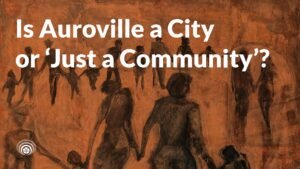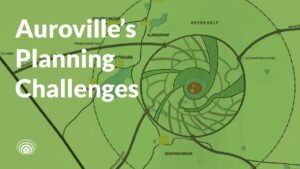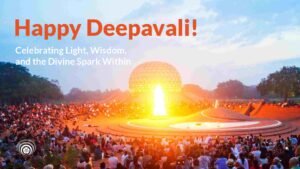
Listen to article here.
A synthesis of vision, collaboration, and conscious action for a collective evolution.
Often, planning is considered to be a dry domain of technocratic exercise, merely for the endeavours of engineers, architects, administrators, and policymakers. Sometimes, in the context of Auroville, the individuals associated with such aptitude or attitude are scoffed at or sidelined as being too material or mental. Yet, if we accept that all life is yoga, then no aspect lies outside the scope of progress. Under the influence of Grace, one is almost compelled to view everything—even strategy and planning—as part of life, making them a possible path of yoga.
When seen through the lens of Integral Yoga, planning becomes a sacred discipline, a purposeful exercise, a seeking for, and attempt at, an offering of synthesis. In the context of Auroville—a place born out of aspiration, not ambition—planning must serve as a bridge between vision and manifestation. For example, between the dream and spirit of the City and its material form and function.
As the adage goes, failing to plan is planning to fail, but planning without purpose is also a form of failure—one that disconnects us from a deeper, wider, and truer progress in our collective journey.
Auroville never sought to be an ordinary settlement. It is a laboratory of evolution, a crucible for the future of human unity. In that sense, every decision we make—social, cultural, economic, ecological, political, technical, legal, ethical—cannot be set aside as administrative acrobatics. For each of these become an occasion for growth, and a matter of conscious action. Thus, every line on a map or a roadmap carries within it a consequence, a collective choice, making our collective life much more than the sum of its individual parts.
Planning, then, must become an essential part of our life in Auroville. This yoga of planning cannot be practiced in the narrow sense of perspective postures or personal preferences, but yoga in the expansive sense Sri Aurobindo intended: a methodical discipline towards the transformation of life itself. The authentic planning process—Yojana Yoga—offered in that sense, can become a subdomain of Karma Yoga: selfless action offered to the Divine.
In Auroville, where material and spiritual aspirations are meant to converge, this alignment must not be incidental or accidental—it must be intentional. The maps we draw, the policies we write, the infrastructure we lay, the business plans we chart—these must seek to be acts of conscious collaboration. True results that are amicable to all, never emerge when planning is merely an outlet for egoic assertion or reactive politics. They can only bear fruit—or flowers—from inner attunement and outer authenticity. It has to be pursued as a collective sadhana, a yoga of will, surrender, courage, discipline, and harmony. Planning in itself must be considered as an action, and thus residents must willingly collaborate and serve it.
Unfortunately, too often in recent years, planning has been reduced to a battleground—between ideologies, interest groups, or interpretations of the past. This is the result, amongst other things, of a shortsighted approach to planning. When our vision is limited to what’s in our sight, we become parochial and narrow-minded. This inevitably ensues in a dogfight between differing perspectives. But this belongs to an old world.
Now is the era of BVR—Beyond Visual Range. We must learn to intentionally look beyond what we habitually see. Strategy begins here: in the ability to hold a broad view and take a synthetic approach. It’s not planning for the sake of planning, but aligning action with a higher consciousness through the intentional organisation of life. Thus, strategic planning seeks to rise above sides—to look beyond our lives, and our lifetime—to suggest that the very way we approach planning must be transformed and re-anchored in the original vision. This is a vital skill—not just for Auroville, but for the world.
This article is a call to such planning. An approach to strategic planning that goes beyond being reactive, but proactive towards the vision. Not rigid, but receptive. Not divisive, but synthesising—and yet decisive. Not for the few, or of the few, but for the whole. In fact, for humanity as a whole. Auroville invites us to see planning as a yogic act—an alignment of thought, vision, collaboration, and action—toward collective and conscious evolution.
Planning as a Yoga?
We often think of yoga as stillness, silence, or inner work. But yoga can also take the shape of a meeting, a map, a draft plan. When we approach planning not as an administrative burden but as a willed act—held in awareness, offered in sincerity—it becomes a form of sādhanā. Planning, then, is no longer about outputs alone, but about outcomes. About the quality of attention we bring to each step.
This doesn’t mean we abandon rigour or clarity. The spirit must not become an excuse for mediocrity. Too often, “purity of intention” is used to mask lack of rigour or avoid accountability. On the contrary, a yogic approach to planning demands more from us—not less. It asks for inner poise and outer precision. It is this union that transforms the planner—not into a manager of outcomes, but a midwife of possibilities. It calls for humility in listening, courage in articulating, and discipline in shaping the field. The real shift is not from action to inaction, but from unconscious action to deliberate offering. Not to escape the complexity, but to enter it with awareness.
When we act from a place of dedication and discipline, offering the labour of their hands, heart, and head to the Divine and to the collective good, the outcome is often more harmonious. Sometimes unexpected. Always truer to the soul of the work. In such a space, even technical tools—spreadsheets, timelines, blueprints—become instruments of collective consciousness.
What if planning, with this approach, became an expression of trust? Moving away from fragmentation. Seeking synthesis—not only between physical components, but also between the tangible and the intangible, the probable and the possible, the practical and the visionary. As Sri Aurobindo envisioned a future where all aspects of life participate in spiritual evolution, so must planning become the art of weaving these threads into a coherent and harmonious whole.
Everything begins with a dream. A vision. Toward something larger, deeper, higher, and truer—starting with the ideal, the intuitive, luminous possibility that seeks expression. Without this, planning becomes sterile or reactive. With vision at the centre, details may fall into place naturally—shaped not by fear or compromise, but by creative alignment. To access this vision, the planner must cultivate their inner compass. Tools, techniques, and policies are valuable, but they cannot replace silence, sincerity, and surrender. The most powerful plans often emerge not in meetings, but in quiet moments of contemplation. When the planner tunes in with receptivity, listens deeply, and aligns with a higher will, planning becomes a form of concentration-in-action.
When approached in this spirit, planning becomes not only a discipline but a delight. Planning as sādhanā becomes planning with joy—an expression of love. The work, no matter how detailed or demanding, becomes luminous. And with that joy, comes beauty. For beauty, too, is a way of the Divine—a special manifestation of the Supreme in Matter, just as Truth is in the mind, Love in the heart, and Power in the vital. As the Mother reminds us, “In the physical the Divine manifests as Beauty.” Planning, then, may become a form of aesthetic offering—in which clarity, harmony, and grace reveal the presence of consciousness in the lines of a layout and the rhythm of a process.
“On the physical plane the Divine expresses himself through beauty, on the mental plane through knowledge, on the vital plane through power and on the psychic plane through love.”
CWM: 15: Chapter 1
“The Divine manifests in the psychic as love, in the mind as knowledge, in the vital as power and in the physical as beauty.”
CWM 13:380
“Beauty is the special divine Manifestation in the physical as Truth is in the mind, Love in the heart, Power in the vital. Beauty is the way in which the physical expresses the Divine — but the principle and law of Beauty is something inward and spiritual which expresses itself through the form.”
Sri Aurobindo CWSA, vol. 27, page 699
(https://integralyoga-auroville.com/glossary/beauty/)
Planning need not be a solitary or elite exercise. When approached with purpose, it becomes a shared field of sādhanā. But true collaboration isn’t vague consensus or endless consultation—it’s a disciplined process of aligning different capacities around a common vision. Participation must be purposeful and structured, with people contributing meaningfully across specific domains—land, economy, education, governance, infrastructure, and more. Each focus area becomes a site for collective intelligence to act. When responsibilities are clarified and processes transparent, collaboration becomes empowering—not chaotic. Strategic planning, then, becomes a choreography of energies. When we bring in diverse perspectives—not to dilute, but to deepen—the field of awareness expands. It’s not merely democratic; it’s dynamic. In this expanded field, new insights may emerge. Planning, then, becomes a shared attunement to the work that wants to be born through us.
Strategic planning unfolds in both time and space—not just as measurable dimensions, but as living fields shaped by perception and culture. Time is not limited to a timeline of deliverables; it is a rhythm of readiness, of cycles of emergence, integration, and shift. Space is not confined to geography or departments—it is context, capacity, and collective attention. To plan well is to recognise how time is felt and how space is held. The best strategies arise when we work with these invisible forces, not against them—when we understand not only the metrics, but the mindsets that organise them. Misaligned planning imposes urgency where patience is needed, or fills space without cultivating presence. True strategic work listens first—to the readiness of time, the receptivity of space, and the consciousness that moves through both.
Ultimately, planning in Auroville must stay attuned to the spiritual core of the Charter, To be a True Aurovilian, and the Dream—as a living, breathing reference point. For this, the aspirant planner must gradually shed the ego, not as a moral gesture, but as a necessary condition for clarity. The need for control, credit, or validation must give way to trust in something deeper. Only then, perhaps, can the Force begin to move through them—unhindered, unseen, but unmistakably present.
When planning becomes ‘Ordinary’
For planning to serve as a form of yoga, it must be rooted in larger purpose, and collective aspiration. But too often—especially in places striving for high ideals like Auroville—planning loses its spiritual core and becomes a dry, reactive, or even divisive affair. The sacred act and responsibility of co-creating the future can devolve into a technocratic exercise, a battlefield of egos, or a repetitive administrative function devoid of soul. It is in these moments that planning becomes ordinary—mechanical, political, or worse, spiritually regressive.
One of the most common pitfalls is when planning becomes a tool of centralised power. Decisions, maps, and mandates imposed without context or co-creation may appear efficient, but they are hollow. They fail to account for the living energy of the place and people. Instead of inviting alignment, they breed resistance, confusion, and eventually apathy. Planning loses its connection to the field it is meant to serve.
Worse still, vision is often hijacked by narrowing ideologies. Whether masked in the language of environmentalism, modernism, traditionalism, or even spirituality, narrow positions can weaponise vision. The result is rigidity, polarisation, and paralysis. Instead of working toward synthesis, we enter a cycle of ideological tug-of-war, where the plan is no longer a living aspiration but a political manifesto to be defended—at any cost.
In this way, planning becomes reactive and emotionally charged. The lofty, synthesising mind of the planner—once capable of holding vision, complexity, and subtle signals—gets entangled in tactical noise and emotional undercurrents. Its natural receptivity dulls under pressure. Inner work is hardly remembered—or at best, sidelined. Personal grievances, historical baggage, and unresolved group dynamics overshadow the clarity required for purposive decision-making. Meetings become arenas for subtle (or overt) battles of will. Fear of change and attachment to outcomes take precedence over openness and conversation. This is where the quieter, steadier voices begin to withdraw, and the loudest or most rigid take the stage. When decisions are made without genuine listening or clarity, people lose trust in the process. Soon, each feels excluded, unheard, and often ends up opposing even well-meaning proposals. What should have been a collaborative unfolding turns into a fractured and alienating experience.
Over the years, a reactive culture has taken root in Auroville. Instead of proactive, strategic evolution, the system has become mired in firefighting, litigation, and last-minute scrambling. There is little spaciousness for long-term visioning. Each week brings a new crisis, each year a new committee, but the deep direction remains elusive. Even the structure of participation becomes skewed. We veer between top-down authoritarianism and bottom-up chaos. Either planners impose plans without listening, or the need for total consensus delays decisions indefinitely. In both extremes, momentum is lost, and polarity replaces progress.
We begin to obsess over form—mistaking beautifully drawn blueprints for the actual force that animates life. Without the inner fire, without inspiring intention, even the most elegant plans fail to manifest. Eventually, energy stalls. Endless consultations, critiques, and revisions exhaust the will to act. This analysis paralysis is often disguised as an inclusive process, but in reality, it becomes a shield against manifestation. And in all this, perhaps the most tragic loss is that of joy, beauty and aspiration. What began as a sacred endeavour becomes a burden. The soul-force behind the planning process dissipates. What could have been an offering to the future becomes just another task on a bureaucratic checklist.
This is the fall—from yoga to roga, from aspiration to administration. Recognising these patterns is not to despair, but to repair our faltering pursuit of perfectibility, to return planning to its rightful place as a collective sādhanā—a conscious work of harmony and progress.
A new strategic approach as the path forward
To reclaim planning as an intentional, transformative act, we must move beyond both centralized control and unanchored consensus—into a new field of collaboration and co-creation. Strategic planning must become sādhanā. Planning, like every action as a potential form of yoga, demands an inner foundation and outer precision. It must be infused with aspiration, guided by collective will, and shaped by collaborative intelligence.
Planning as sādhanā begins with cultivating an inner space—quiet enough for imagination, still enough for foresight, and open enough for vision. For this, poised silence before meetings, reflection after decisions, the invocation of collective aspiration—are not indulgences, nor must they become outward forms and acts, but essential ingredients. Perhaps, they are necessary protocols for any work meant to shape the future. When groups gather seeking not to debate or convince but to align, to listen not only to oneself, not only to one another but also to the deeper call of the place and the time, a higher order of planning may perhaps begin to emerge. That deeper call anchors itself in the call of the Charter of Auroville and Sri Aurobindo’s evolutionary vision and of that great adventure.
Resident participation and functioning, then, is not a dry formality but a crucial warm engagement in co-creation. Structured, transparent methods of dialogue must be developed—methods that honour both efficiency and expectations. When people feel genuinely heard, and when the process is clear, trust may little by little be restored or take hold.
Working groups, too, must evolve from embattled administrative cells to sādhak teams. Simultaneously, the collective must support a culture in which decision-making bodies are spaces of humility, mutual learning, and dedicated service. This also means actively cultivating the collective capacity to organise—sharpening our ability to structure, synthesise, and sequence tasks with clarity and confidence. Organisation is not antithetical to aspiration; actually, it is what helps translate vision into practice. Without this ability, even the sincerest intention remains scattered, unfulfilled. When ego begins to be set aside and the work is seen as an offering, collective organisation becomes a field of growth. In this way, the working groups may emerge as spaces for willing servitors, instead of being coveted places of power.
We must reorient our approach to planning as a dynamic and living practice—one that mirrors Auroville’s own evolutionary purpose. This is not a place for fixed conclusions or rigid control, but for purposeful growth through unfolding. To plan here is not to dictate but to dedicate; not to finalise but to cultivate. In Auroville, where work is meant to be a means of self-expression and service to the whole, planning must embody this same spirit: ceaseless, contextual, and conscious.
From day one, Auroville invites us toward a Living Plan—a luminous vision first expressed through the Galaxy Model, proposed to and approved by the Mother, and later formalised as the Master Plan by the residents and gazetted by the Government of India. This foundational gesture in physical planning offers a starting point. From here, the same clarity and integral spirit can be extended into all domains of collective life: economic frameworks, systems of governance, cultural evolution, education, ecology, and wellbeing. The future cannot be built in fragments.
For this unique and novel experiment to realise its true scope, numbers matter—not as metrics of success, but as instruments of force. The Dream needs people—souls willing to serve, grow, and organise—to realise the ideal. The Mother envisaged a population of about 50000 willing servitors committed to the realisation of human unity. Now, Auroville has approximately 2500 residents after 57 years. Now, as the collective grows, so too must our capacity to hold it—carefully, harmoniously, effectively. In this context, the need for organisation in Auroville, then, is not bureaucratic; it is spiritual. Planning becomes a bridge between the inner and outer, the individual and the collective, the ideal and its expression. It is through the careful weaving of these dimensions—inner aspiration, interpersonal growth, and internal frameworks—that the City of the Future can begin to take form. In true sense.
Additionally, Auroville was never meant to be just a township, a retreating ashram, or an ecovillage. It is a living laboratory for the evolution of consciousness—a bold attempt to manifest a higher way of being in matter, spirit, and collective organisation. We are not here to replicate the structures of the past, but to embody a possibility not yet seen. Not for ourselves, but for something greater.
As the Mother said: “You say that Auroville is a dream. Yes, it is a dream of the Lord—and generally these dreams turn out to be true, much more true than human so-called realities.” This Dream is not ours to possess, but to serve. Everything in Auroville, including ourselves, is lent to us by the Divine—entrusted for a purpose greater than our preferences or opinions. To give form to such a vision, strategic planning is not optional or preferential—it is essential. Our planning, meant to manifest the Unmanifest, must be grounded in sincerity of purpose and humility of attitude, carried with gratitude for the opportunity to serve. It must move forward with perseverance and aspiration, guided by receptivity to the deeper Will and an unwavering commitment to progress. It must be shaped by courage to face the unknown, infused with goodness in intent, generosity in spirit, and upheld by a deep sense of equality among all who participate. Above all, it must be rooted in peace—a peace that holds, heals, and harmonises. We must walk the subtle path between silence, system, and structures, between aspiration and action—shaping a city that breathes consciousness into material form.
After all, Auroville is not a normal city just to be lived—it is an ideal to be manifested. Not simply inhabited by residents, but intentionally shaped by servitors. In that spirit, strategic planning exercises must be undertaken not for control, but for coherence and clarity; not to impose order, but to invite meaning and collaboration. The work of building Auroville is not about mentally drawing lines on paper—it is about aligning with a Force that seeks to express itself through physical forms, vital functions, and express yet unknown psychic rhythms.
We need to plan because the Dream deserves a body. We need to plan to participate in its becoming. We need to plan to free—space, time, energy, intention. We need to plan to give shape to a City with a Soul. And we need a plan that is more than a method—we need meaning.
Perhaps we can offer a luminous twist to the old adage: If failing to plan is planning to fail, then meaning to plan is planning to mean.
Then we may begin to embody a little of what Sri Aurobindo called The Life Divine—not as a distant ideal, but as a daily discipline and a living practice of clarity, courage, and collective work.
In such a space, strategic planning work shall dissolve into roles of stewardship of conscious actions. In collaboration the work of organising transforms into a shared trust. It becomes an offering. An intentional collective alignment of will, vision, and aspiration. A daily discipline of harmony. A practice of the possible. It becomes yoga.





